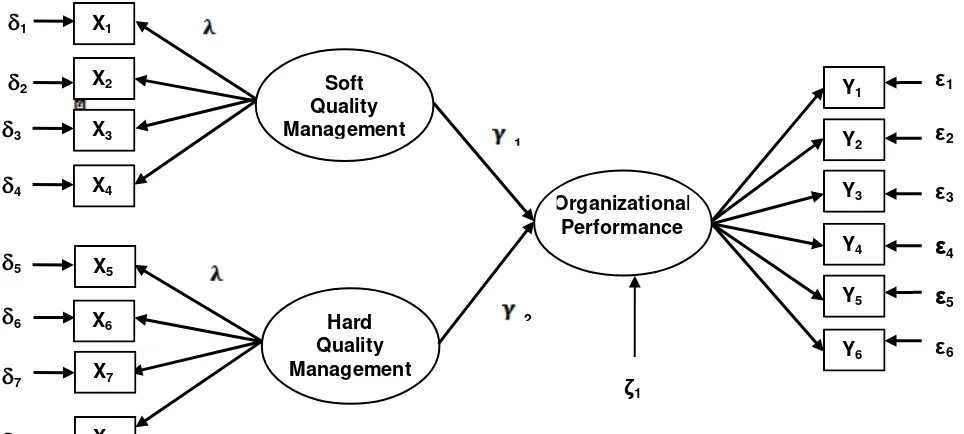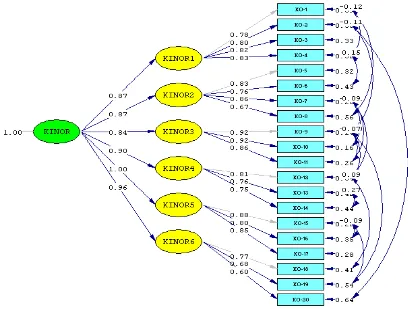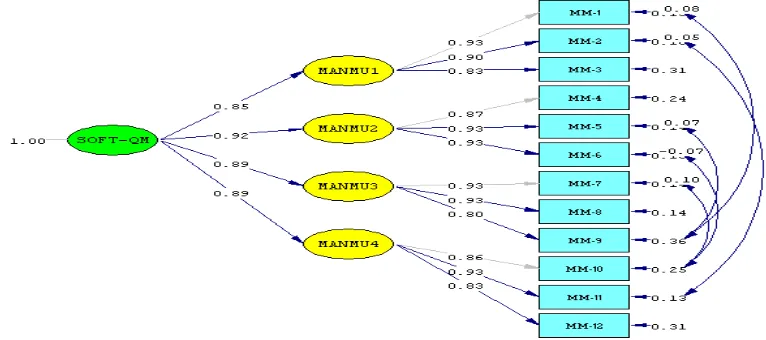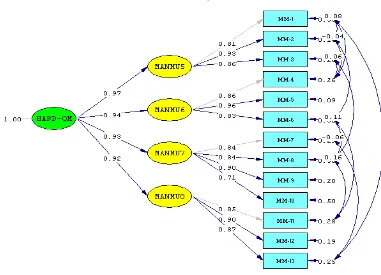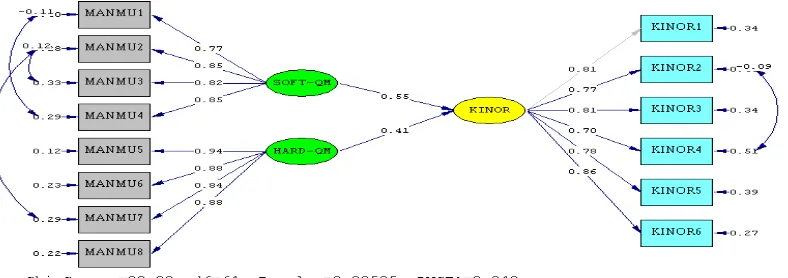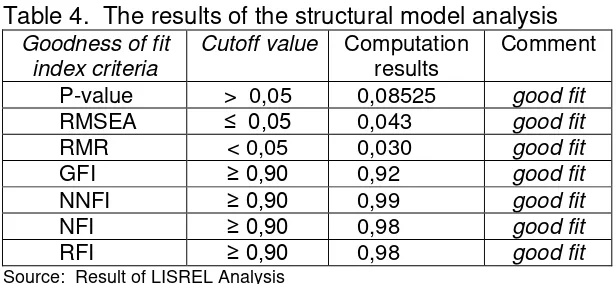The Effects Structural Model of Hard and Soft Quality
Management on Organizational Performance Improvement
in Vocational High Schools
Giri Wiyono
Yogyakarta State University [email protected]
Abstract
The objective of this research was to examine: the effect of soft quality management aspects on organizational performance at the Vocational High Schools, and the effect of hard quality management aspects on organizational performance at the Vocational High Schools. The type of research was ex post facto by the survey method. This was carried out at the Vocational High Schools located in Yogyakarta Special Region, covering Yogyakarta, Sleman, Bantul, Kulonprogo, and Gunungkidul. The sample consisted of 139 the Vocational High Schools. Subjects were the managerial staffs at the Vocational High Schools including the principals, deputy principals, and heads of department at the Vocational High Schools. Data were collected by using questionnaires. The test for the validity and reliability of the indicators of constructs was done through confirmatory factor analysis. This research used structural equation modeling analysis. The results of the research were: (1) soft quality management aspects had a positive effect on organizational performance at the Vocational High Schools, and (2) hard quality management aspects had a positive effect on organizational performance at the Vocational High Schools.
Keywords: Total Quality Management (TQM); Organizational performance; Vocational High Schools
INTRODUCTION
Total Quality Management (TQM) is one of the key components in regulating
the dynamic environment of an organization, so that the organization has a high
performance (Schermerhorn, Hunt & Osborn, 2003:26). TQM becomes an important
issue in the development of the organization. Even Dale and Bunney (1999:25) state
that currently most organizations work with TQM.
This moment the evolution of quality management system has entered the
Total Quality Management (TQM). The stages of quality management system
hierarchy are as follows: (1) inspection, (2) quality control, (3) quality assurance, and
(4) quality management or total quality management (Sallis, 2002:19-20) Pike and
management. Overall the management system comprising quality management and
total quality management is seen as a management philosophy (Wilkinson, et al.,
1998:183). Thus both have the same function continuously to improve the quality
and performance of the organization for meeting the needs of its customers.
In the context of education, TQM is a new thing. Sallis (2002:27) defines the
concept of TQM in education as follows: "TQM is a philosophy of continuous improvement, which can provide any educational institution with a set of practical tools for meeting and exceeding present and future customers needs, wants, and expectations". This definition gives the notion that TQM is a philosophy of continuous improvement which can provide a set of practical tools at any educational institution
in meeting the needs, wants, and expectations of its customers, now and in the
future. Thus, TQM is a philosophy about education improvement in school that is
done continuously by using a set of principles for managing the school organization.
In connection with the implementation of TQM, Fields (1994:23-25) states that
the application of TQM in education is done in the form of the application of the TQM
principles. Even Weller in the West-Burnham (1998:320) concluded that the
application of TQM principles shows the positive results, so that schools adopt TQM
as the process of reconstruction of education in schools.
According to the standard ISO 9001:2000, there are eight principles of the
quality management system, namely: focus on the customer, leadership,
the involvement of all people, process approach, system approach, continual
improvement, the fact approach to decision-making, and mutual beneficial customers
relationship (Point Development International, 2008:4). Therefore, the eight main
principles of the quality management system become a standard in the application of
TQM in schools.
Wilkinson, et al. (1998:14-15) say that. implementation of TQM contains two
aspects, namely hard quality management, and soft quality management. Hard
quality management is related to the production orientation and emphasis on
systems, data collection, and measurement. Meanwhile, soft quality management is
related to human resource management in organizations including commitment,
cooperation, involvement, training, and so on. In this study, soft quality management
has four dimensions, namely: (1) leadership, (2) focus on the customer,
(3) the involvement of all people, and (4) mutual beneficial customer relationship.
(1) the process approach, (2) system approach, (3) continuous improvement, and
(4) the fact approach to decision-making.
Currently the management of education in Indonesia has implemented
the school-based management (SBM). In implementing SBM in Vocational High
Schools are carried out by developing the Quality Management System of ISO
9001:2000 (ISO 9001:2008) standard (Directorate General of Primary and
Secondary Education- Ministry of National Education, 2009: 128-134). The TQM is
the foundation of quality management system of ISO 9001 standard. Thus,
the vocational high schools in Indonesia, which have the certification of the Quality
Management System of ISO 9001:2008 standard, have implemented TQM in
management education to compete globally. According to Fields, the application of
TQM principles and organizational performance shows high student achievement
(1994:xxx).
In the context of education, the school is an organization. Dimensions of school
management are grouped into three categories, namely: input, process, and output
(Lunenburg & Ornstein, 2000:16-18) School as a system has components, such as
inputs, processes, and outputs that will affect the successful achievement of
objectives and outcomes of school (Mulyasa, 2010:44). For that, all components
need to be empowered to achieve school goals.
School performance can be measured from inputs, processes, outputs,
outcomes, productivity, efficiency, and effectiveness (Slamet PH., 2004:8). These
measures serve as benchmarks to assess the performance of the school
organization. So the school organizational performance measurement is essential to
make the efficiency and effectiveness of an organization. In this study the
performance of the school organization has six dimensions, namely: (1) the process
of organization, (2) the output of organization, (3) the results of organization,
(4) the efficiency of organization, (5) the effectiveness of organization, and
(6) the productivity of organization.
The implementation of quality management in vocational high schools is
expected to improve the performance of school organization. Thus, the application of
the principles of quality management is urgent for Vocational High Schools that wish
to improve their school performance. Therefore, this research is important to deeply
investigate the effect of the application of total quality management, both soft quality
in Vocational High Schools. The results of this research will provide a constructive
recommendations to improve organizational performance in Vocational High Schools
which apply the principles of the quality management system of ISO 9001 standard,
so that this has an impact on improving the quality of Vocational High Schools.
RESEARCH METHODOLOGY
This research used an analysis unit of school organization. The population in
this research was all public and private Vocational High Schools in Yogyakarta
Special Region which have gained the certification of Quality Management System
ISO 9001:2000/ISO 9001:2008 standard or are currently in the process of
certification. The samples in this research consisted of 139 vocational high schools.
Subjects were the managerial staffs at the Vocational High Schools including the
principals, deputy principals, and heads of department. In this research, there are
two exogenous latent variables, namely: soft quality management (
ξ
1), and hardquality management (
ξ
2), as well as the endogenous latent variables, namely theperformance of the organization (
η
1).In this research, the test for the validity and reliability of the indicators of
constructs was done through a measurement model with Confirmatory Factor
Analysis (CFA). This research used the Structural Equation Modeling (SEM) with
Lisrel 8.70 program.
The hypotheses in this research were that: (1) there is a positive effect of the
soft quality management on organizational performance in Vocational High Schools,
and (2) there is a positive effect of the hard quality management on organizational
performance in Vocational High Schools. The structural model of the relationship
Figure 1. The structural model of the relationship between variables
Specification :
X1 : leadership, Y1 : the process of organization
X2 : focus on the customer, Y2 : the output of organization
X3 : the involvement of all person, Y3 : the results of organization
X4 : mutual beneficial customer relationship, Y4 : the efficiency of organization
X5 : the process approach, Y5 : the effectiveness of organization
X6 : the system approach to management, Y6 : the productivity of organization
X7 : continuous improvement,
X8 : the fact approach to decision-making
X : lambda X, the coefficients of factor loading on the exogenous manifest variables, y : lambda Y, the coefficient of factor loading on the endogenous manifest variables,
: theta - delta, the measurement errors on the exogenous manifest variables, ε : theta - epsilon, the measurement errors on the endogenous manifest variables,
: gamma, the path coefficients of exogenous latent variables on the endogenous latent variables
: zeta, error variance in structural model equation
RESULTS
Latent Variable Measurement Model
This study uses the second order confirmatory factor analysis (CFA).
Measurements on the second order CFA shows the relationship between the
indicators and the latent variables (constructs). The results of testing using the
second order CFA for measuring the organizational performance construct (KINOR)
Figure 2 The test results of the organizational performance construct
The test results of the second order CFA of organizational performance
construct (KINOR) produces the goodness of fit index for p-value is 0,06836 and
RMSEA is 0,036. This measurement model is fit after a modification of the model by
freeing parameters of the indicators of organizational performance construct, so that
parameters correlate with each other. Thus, this measurement model meets the
statistical requirements and it is categorized as a measurement model that fits to
measure the construct of organizational performance. The results of testing the
second order CFA are shown in the following table 1.
Table 1. The test results of the organizational performance construct
Dimension Standardized Factor Loading
Standard Error
tvalue R2 Comment
KINOR-1 0,87 0,07 9,30 0,76 significant
KINOR-2 0,87 0,07 9,87 0,76 significant
KINOR-3 0,84 0,07 10,98 0,71 significant
KINOR-4 0,90 0,07 9,88 0,82 significant
KINOR-5 1,00 0,07 12,98 1,01 significant
KINOR-6 0,96 0,07 9,99 0,92 significant
From table 1, it can be concluded that the organizational performance construct
produces six significant dimensions and coefficient values of standardized factor
loading which over 0,50 with a t-value greater than 1,96. Meanwhile, the coefficient of
construct reliability for organizational performance construct is greater than 0,70.
This means that the indicators and dimensions used to measure organizational
performance construct have adequate validity and reliability.
The testing results of the second order CFA measurement model for a soft
quality management construct is drawn within the path diagram in figure 3.
Figure 3. The test results of the soft quality management construct
The test results of the second order CFA of soft quality management construct
(Soft QM) produces p-value = 0,08019 (p-value> 0,05) and RMSEA = 0,047
(RMSEA < 0,05 ). This measurement model is fit after a modification of the model by
freeing parameters of the indicators of soft quality management construct, so that
parameters correlate with each other.
Thus, this measurement model meets the statistical requirements and it is
categorized as a measurement model that fit to measure the construct of soft quality
managemen. The results of testing the second order CFA are shown in the following
table 2.
Table 2. The test results of second order CFA soft quality management construct
Dimension Standardized
Factor Loading
Standard Error
tvalue R2 Comment
MANMU-1 0,85 0,07 11,03 0,72 significant
MANMU-2 0,92 0,07 11,34 0,85 significant
MANMU-3 0,89 0,07 11,62 0,79 significant
MANMU-4 0,89 0,07 10,58 0,78 significant
From table 2, it can be concluded that the soft quality management construct
produces four significant dimensions and coefficient values of standardized factor
loading has over 0,50 with a t-value greater than 1,96. Meanwhile, the coefficient of
construct reliability for a soft quality management construct is greater than 0,70. This
means that the indicators and dimensions used to measure the soft quality
management construct have adequate validity and reliability.
The testing results of the second order CFA measurement model for a hard
quality management construct is shown within path diagram in figure 4.
Figure 4. The test results of the hard quality management construct
The test results of the second order CFA of hard quality management construct
(Hard QM) produces p-value = 0,07198 ( p-value> 0,05 ) and RMSEA = 0,047
(RMSEA < 0,05). This measurement model is fit after a modification of the model by
freeing parameters of the indicators of hard quality management construct, so that
Thus, this measurement model meets the statistical requirements and it is
categorized as a measurement model that fit to measure the construct of hard quality
management. The results of testing the second order CFA are shown in the following
table 3.
Table 3. The test results of second order CFA hard quality management construct
Dimension Standardized
Factor Loading
Standard Error
tvalue R2 Comment
MANMU-5 0,97 0,07 10,91 0,95 significant
MANMU-6 0,94 0,07 11,33 0,88 significant
MANMU-7 0,93 0,07 11,06 0,87 significant
MANMU-8 0,92 0,07 11,08 0,85 significant
Construct Reliability (CR) 0,88 good Source: Result of LISREL Analysis
From table 3, it can conclude that the hard quality management construct
produces four significant dimensions and coefficient values of standardized factor
loading has over 0,50 with a t-value greater than 1,96. Meanwhile, the coefficient of
construct reliability for a hard quality management construct is greater than 0,70.
This means that the indicators and dimensions used to measure the hard quality
management construct have adequate validity and reliability.
Thus, it can be concluded that the indicators and dimensions used to measure
the constructs of organizational performance, soft quality management, and hard
quality management have adequate validity and reliability.
The Structural Model of Latent Variable Relationships
The results of structural model testing is obtained the model of causal
relationships between two exogenous latent variables (soft quality management, and
hard quality management) with one endogenous latent variable (organizational
performance) which is shown within path diagram in figure 5.
The results of the standardized structural equation model analysis is obtained 7
values that meet goodness of fit index criteria. This results are shown in the following
table 4.
Table 4. The results of the structural model analysis
Goodness of fit index criteria
Cutoff value Computation results
Source: Result of LISREL Analysis
From table 4, it can conclude that the structural model meets some criterias in
testing of the model fit and it is categorized as a model that fit to the data. The test
results of the structural equation model are obtained the parameters of estimated
Lambda-X (λx) as standardized factor loading coefficients that are shown in the
following table 5.
Table 5. The results of estimated Lambda-X parameter
Measurement
Source: Result of LISREL Analysis
From table 5, it can conclude that t-test values of all observed variables of soft
quality management (X1 - X4) and hard quality management (X5 - X8) are greater
than 1,96 ( t-test > 1,96 ), so that they can be declared significant. Besides, the values
of the standardized factor loading coefficient (λx) have over above 0,50 so that they
can be categorized as good. This means that the observed variables can be used
to measure significantly the latent variables of soft quality management and hard
The test results of the structural equation model are obtained the parameters of
estimated Lambda-Y (λy) as standardized factor loading coefficients that are shown
in the following table 6.
Table 6 The results of estimated Lambda-Y parameter
Measurement
Source: Result of LISREL Analysis
From table 6, it can conclude that t-test values of all observed variables of
organizational performance (Y1 - Y6) are greater than 1,96 ( t-test > 1,96 ), so that they
can be declared significant. Besides, the values of the standardized factor loading
coefficient (λy) have over above 0,50 so that they can be categorized as good. This means that the observed variables can be used to measure significantly the latent
variables of organizational performance.
The results of the hypotheses testing are obtained the gamma parameters (γ) as the direct effect of soft quality management, and hard quality management latent
variables on organizational performance latent variables that are shown in the
following table 7.
Table 7. The testing results of parameter Gamma (γ)
GAMMA
Sumber: Hasil Analisis LISREL
From table 7, the results of the hypotheses testing produces the value of the
path coefficient (γ1) = 0,44 with the value of the t-value = 2,71 and the value of path
coefficient (γ2) = 0,33 with the value of the t-value = 2,04. This results show that the
t-test value for two paths coefficient values are greater than 1,96 ( t-test > 1,96 ). Thus,
this results can be concluded that both the path coefficients are significant, so that
It can be concluded that this research hypotheses have been proven, namely:
(1) there is a positive effect of the soft quality management on organizational
performance in Vocational High Schools, and (2) there is a positive effect of the hard
quality management on organizational performance in Vocational High Schools.
The results of this research also concluded that the magnitude of the effect of the
soft quality management on the organizational performance is 0,44 or (0,44)2 by
19,36%; and the effect of the hard quality management on the organizational
performance is 0,33 or (0,33)2 by 10,89%. Meanwhile, the magnitude of the effect of
the soft quality management and hard quality management together on the
organizational performance is 0,88 or 88%. This provides a common fact that the
soft quality management and hard quality management provide a major influence on
organizational performance improvement at the Vocational High Schools in DIY .
The findings of this research support the results of empirical study conducted
by Ling Xi Li (1997:535-545) that examined the relationship between the
implementation of quality management and organizational performance by
examining the effect of each of the principles of quality management on the
organization's service quality performance. This study results explain that there is a
relationship between the determinants of quality management and service quality
performance .
The results of this study also support the findings of a study conducted by Noor
Hazilah (2005:204-216 ) about how the quality management practices in Malaysian
hospitals. This study shows that there are eight quality management principles
applied in practice and the results is concluded that there is a relationship between
the application of quality management principles and the organization's service
quality performance.
Thus, the results of this research reinforce some other research studies related
to the application of the principles of quality management. In this research, the
application of the principles of quality management are grouped into two aspects,
namely hard quality management, and soft quality management. The hard quality
management relate to: the process approach, the system approach to management,
continuous improvement, and the fact approach to decision-making. Meanwhile, the
soft quality management related to: leadership, focus on the customer, the
involvement of all people, and mutual beneficial customer relationships. This
organizational performance. It can be concluded that there are effect of the soft
quality management, and hard quality management on the organizational
performance at the Vocational High Schools in DIY. This shows that the
organizational performance in Vocational High Schools can be improved by
increasing the quality of soft quality management related to leadership, focus on the
customer, the involvement of all people, mutual beneficial customer relationships,
and improving the quality of hard quality management related to the process
approach, the systems approach on management, continuous improvement, and the
fact approach to decision-making. The findings of this research also provide
information that improving the quality of soft quality management provide a greater
contribution in the improvement of organizational performance at the Vocational High
Schools in DIY compared to the hard quality management improvement.
In the context of vocational education, the findings of this research show that
the application of the soft quality management principles in Vocational High Schools
gives greater the influence in the improvement of organizational performance in
Vocational High Schools compared with application of the hard quality management
principles. Therefore, improving the soft quality management related to leadership,
focus on the customer, the involvement of all people, mutual beneficial customer
relationship needs to be prioritized in the application of the principles of quality
management in Vocational High Schools. This is important because it provides a
greater influence in the improvement of organizational performance at the Vocational
High Schools in DIY.
So far, the most of the Vocational High Schools in DIY have implemented the
quality management systems. It is indicated from the number of Vocational High
Schools that have obtained the certification of Quality Management System ISO
9001: 2008 standard. This certification is awarded to at the Vocational High Schools
that have implemented quality management system at their institution and audited by
competent authorities, so that for graduating from these audits will get the certificate
of ISO 9001: 2008 standard. Thus, the application of quality management system at
the Vocational High Schools in DIY impacts on improving organizational
performance at the Vocational High Schools in DIY. The quality management
focuses on the customer service, so that the application of quality management is
capable of changing the mindset of managerial staffs at the Vocational High Schools
Thus, the application of the quality management principles at the Vocational High
Schools in DIY impacts in improving the organizational performance at the
Vocational High Schools in DIY. This condition will impacts on improving the quality
of Vocational High Schools.
Conclusion
The results of this research can be summarized as follows: (1) the soft quality
management has positive effect on organizational performance in Vocational High
Schools, and (2) the hard quality management has positive effect on organizational
performance in Vocational High Schools. These results imply that the level of quality
of the organizational performance in Vocational High Schools influenced strongly by
the quality of soft quality management, and hard quality management. Thus,
improving the quality management can affect on improving the quality of
organizational performance in Vocational High Schools. This will certainly have an
impact on improving the quality of vocational education in DIY.
References
Dale, Barrie, dan Heather Bunney. (1999). Total Quality Management Blueprint.
Oxford: Blackwell.
Fields, Joseph C. (1994). Total Quality for schools, a Guide for Implementation.
Wiscounsin: ASQC Quality Press.
Joreskog, Karl & Dag Sorbom. (1996). Lisrel 8: User’s Reference Guide. Chicago: Scientific Software International.
Lunenburg, Fred C. dan Allan C. (2000). Ornstein. Educational Administration, 3rd Edition. Singapore: Wadsworth.
Pike, John dan Richard Barnes. (1994). TQM In Action: A Practical Approach to Continuous Performance Improvement. London: Chapman & Hall.
Point Development International. Quality Management System. (2008). Yogyakarta: Point Development International.
Sallis, Edward. (2002). Total Quality Management in Education Third Edition.
London: Kogan Page Ltd.
Schermerhorn, John R. Jr., James G. Hunt, dan Richard N. (2003). Osborn.
Organizational Behavior, Eighth Edition. New York, USA, John Wiley.
Setyo Hari Wijanto. (2008). Structural Equation Modeling with LISREL 8.8: Concepts, and Tutorial. Yogyakarta: Graha Ilmu.
West-Burnham. (1998). Understanding Quality, dalam “The Principles and Practice of Educational Management”. England: Pearson Education Ltd.
Wilkinson, Adrian, et al. (1998). Managing with Total Quality Management, Theory and Practice. London: MacMillan Press Ltd.
Xi Li, Ling. (1997). “Relationships between Determinants of Hospital Quality Management and Service Quality Perfomance–a Path Analytic Model,”
